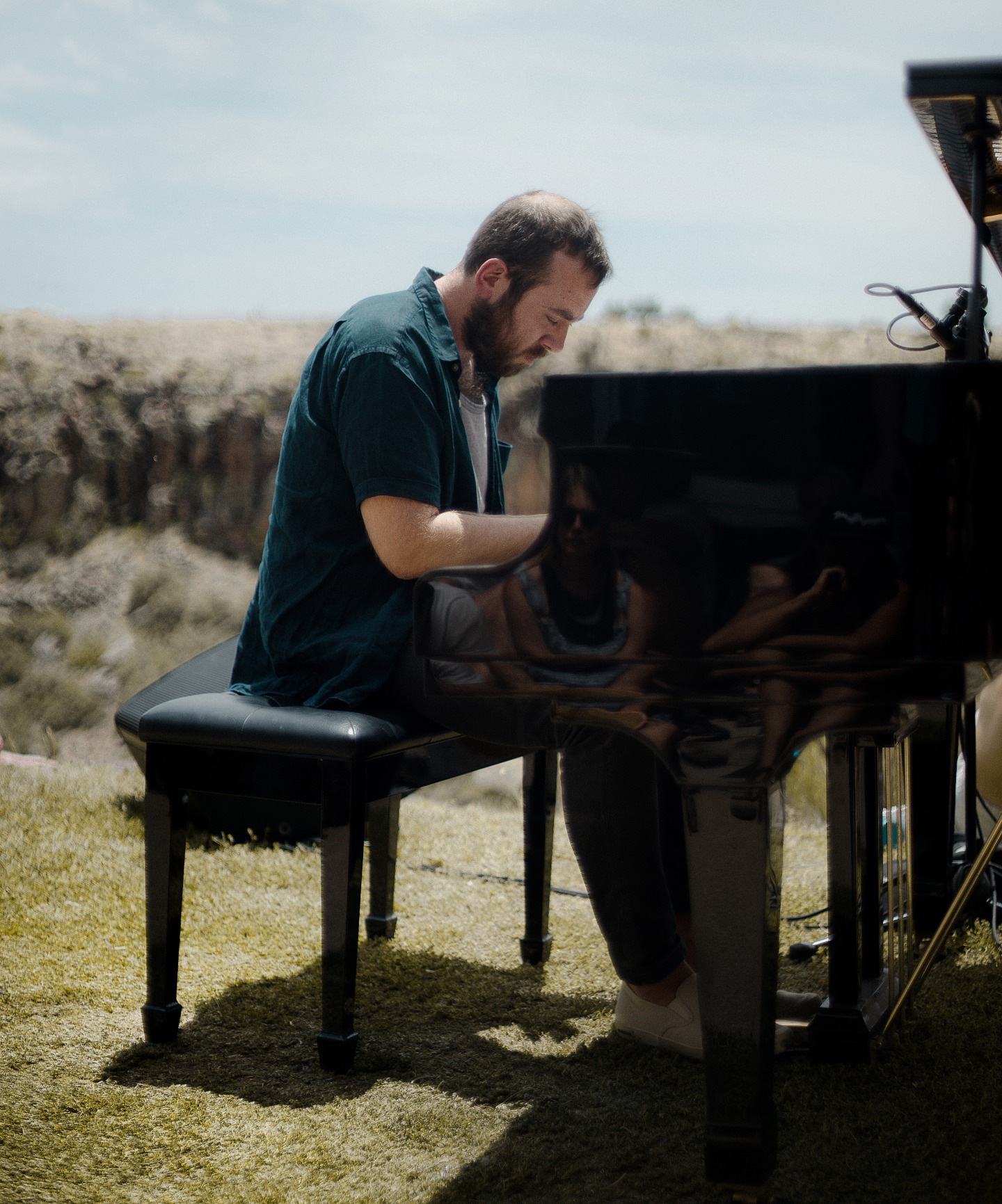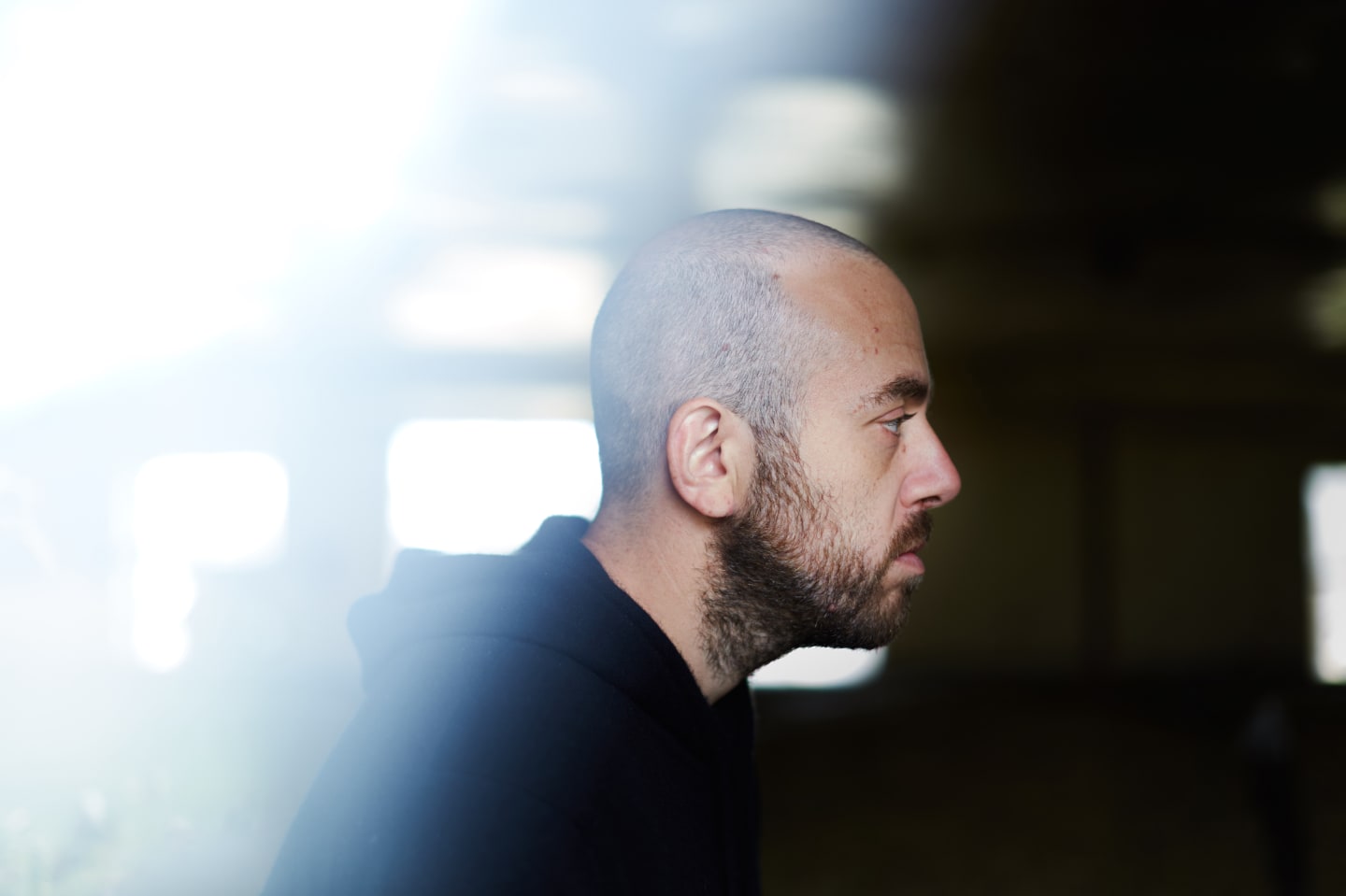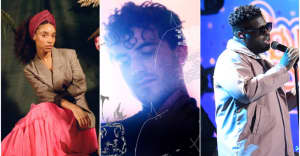17 Pianos Helped Make The New Bing & Ruth Album. Here’s The Story Behind Them.
New York composer David Moore takes us on a journey through the writing of his new album on 4AD, No Home of the Mind.
 Bing & Ruth's David Moore performing at FORM Arcosanti, Arizona, in May 2015
Photo by Tonje Thilesen
Bing & Ruth's David Moore performing at FORM Arcosanti, Arizona, in May 2015
Photo by Tonje Thilesen
“The piano is the language in which my thoughts form,” said David Moore, meditatively, in a recent phone conversation. For the past decade, the New York composer and pianist has led the evocative ensemble Bing & Ruth, who write fluttering, smeared instrumentals that center around the 33-year-old’s elegant themes, which echo but aren’t beholden to the so-called minimalists. He began piano lessons at the age of six under the rigorous Suzuki method — a style that emphasizes memorization over sight reading — and he’s remained ceaselessly curious about the instrument ever since. “I've dedicated my life to the piano,” he said, “and I'm not even close to getting at what’s possible on it.”
On February 17, 4AD will release Bing & Ruth’s No Home of the Mind, the follow-up to 2014’s acclaimed, rain-shower-of-an-album Tomorrow Was the Golden Age, which won the praise of Radiohead’s Thom Yorke, among others. Over 20-odd months, Moore wrote No Home... on 17 pianos across five countries, from Abbeville, Alabama to Bordeaux, France. He honed new harmonic and rhythmic languages, envisioning feats on the piano that, initially, he wasn’t sure he could actually perform. Listen to “Starwood Choker,” for example, with its stacks of furious chords that blur into solemn, swarming drones. Where are the seams? It’s almost impossible to tell.
“This music wasn’t written down ahead of time,” Moore explained of his process. “It resulted from walking up to a piano and playing with no idea of what would come. The pianos themselves played a role, but so did the experience of where I was physically and mentally, and what was happening around me.”
Below, Moore tells the story behind each of the 17 pianos he used to write his most anticipated record to date.
1. Baby grand
Location: FORM Arcosanti, Arizona
David Moore: A video team wanted to film me performing on the side of a cliff. As I was getting acquainted with the piano, I started playing what eventually became "Form Takes" from the new record. It wasn’t a nice piano, but it had character and was percussive, which is why the song sounds how it sounds. I was inspired, being in a collaborative, free-thinking environment, playing this piano on the edge of a cliff.
I hadn't written anything since Tomorrow Was the Golden Age was released, and the technique that I developed on the cliff ended up influencing how I thought of the harmonic movement of the record, how I thought about holding out long tones on an instrument that doesn't sustain. I was trying to come up with a way that the piano could feel more like an organ. That was the first time I used this new technique to do that. It just happened.
2. Spinet
Location: Parabolic glass house, California Redwoods, 400 acres in Mendocino county
I played [a] show in San Francisco, and [my partner] Emily and I wanted to work somewhere out West afterward. She stumbled across this place, owned by an old man who’s a total character and very inspiring. His place has a spinet, and this one had a lot of body, which is rare. It didn’t have a lot of bottom end, but the tones were super clear.
Initially, I wanted to go to the woods and write the record in three weeks, and I quickly realized that wasn't going to happen, so I spent time exploring, trying to get away from functional harmonic voicings — triads, that sort of thing. And I began experimenting with “stacks,” taking different intervalic relationships and moving them around in parallel or not in parallel.
I wrote one of the sections of “Starwood Choker” in this house, but mostly that was a time spent trying to move beyond what I'd done on Tomorrow Was the Golden Age.
3. Very large, old, refurbished upright
Location: Emily’s aunt’s house, San Luis Obispo, California
After the glass house, we traveled to L.A. because two friends needed a dog sitter. On the way, we stayed with Emily’s aunt — she's not actually an aunt, but that's the nature of the relationship — for a couple nights, and she had this monster of a piano. I think it was a Steinway, but I'm not sure. She got the piano tuned and regulated, so it was in great condition. It was bottom heavy and the notes had so much weight. I started messing around with it as soon as we arrived.
I finished writing “As Much as Possible” on that piano, and “The How of it Sped” got more put into place there. Both those songs rely on this heavier left hand drone ostinato, with the low end. That piano had a ton of low end.
4. Beautiful-sounding wurlitzer spinet
Location: Porcelain Raft's studio, Highland Park, California
I'm totally in love with this piano. I've told my friend Mauro [a.k.a. Porcelain Raft] many times how lucky he is to own it, because it's very rare to find a spinet that old and in that good of condition. It has such a pure, soft tone, and an even amount of body and clarity. I worked through much of the new record on this piano.
I’d play the same song over and over for days on end there, really honing in. That’s where “The How of it Sped” came up. That's where “As Much As Possible” happened. I wrote a ton of stuff while I was there.
5. Yamaha baby grand
Location: Moore’s parents’ home, Tecumseh, Kansas
My uncle passed away and I went back to Kansas for his funeral, and it was very sad, as funerals are. I came home from the funeral, sat down at the piano and started playing “What Ash It Flow Up.” I added a couple things later, but it more or less came out in its final form. It wasn't until late in the process of making No Home of the Mind that I remembered the idea, went back, listened and thought it worth exploring further.
This piano is kind of a flat instrument, where everything just sounds like it should. The tonal characteristics affected what happened in that song. I don't think it would've happened on a different piano.
6. Yamaha U1 studio upright
Location: Moore’s studio, Brooklyn
I bought this piano in 2006, and I wrote City Lake and Tomorrow Was the Golden Age on it. I probably played a couple hundred pianos before I picked this one, but I knew this was it the moment that I hit the first chord.
My piano has a softer attack, more so than a lot of older pianos. It's a really even play, and the tones are really clear, but they're not sharp. They don't have a lot of point on them unless you dig in. It's got a lot of low end, but it's a clear low end. I'm gushing. I miss my piano, living upstate. It drives me crazy that I don't have it here.
“Chonchos” was written on this piano, and I think that song is the best thing I've ever written. It’s the culmination of the exploring I was doing with intervalic stacks, using the things that I felt I was good at and moving them in a new direction.
I knew we'd eventually be recording the album on one piano, so my studio was a great place to test all the ideas in one place.
7.Old Steinway upright
Location: 50,000 square foot warehouse at Knockdown Center, Maspeth, New York
I was booked to perform a live improvisational score at Fable with Mauro Remiddi and Hannah Epperson, and there was a Steinway upright where we were set to perform. It was a 20-minute or so walk from the train to the venue, if you walk as slowly as I do, and one day it started pouring rain. I didn’t have an umbrella, so I showed up one day soaking wet, sat down and started messing around.
The piano was beautiful, especially for that giant empty space. The natural reverb was amazing. It put me in a zone to write. Eventually I started playing what became “Scrapes.”
8. Yamaha grand
Location: Pianocenter Berlin, Germany
I had some days off between a solo show in Germany and the start of a short run with the band in London, and I was working hardcore on the record. A friend pointed me to Pianocenter and I rented a room there for three days, and the experience reminded me of being at conservatory years ago, in a tiny room with a piano with no windows, just working. The piano wasn't memorable, and I didn't walk out of there with any new songs, but Berlin offered me a chance to go into practice mode, to start working with the ideas that I had and these different techniques — figuring out how my fingers were going to fit together. I was pushing myself hard technically with this record, trying to pull things off that I didn't yet know how to do.
 Bing & Ruth's David Moore
Photo by Emily Johnston
Bing & Ruth's David Moore
Photo by Emily Johnston
“Every piano, no matter how shitty, has something.”
9. Great old upright, found by chance
Location: Airbnb in Shoreditch, London
We had a few days to kill, so we booked this place, and only later did I notice it had an incredible piano. It had a very soft tone at a low volume and a very harsh tone at a high volume. It was versatile, and it had a lot of low end.
This was not a traditionally good piano, but it had character. In fact, most of the pianos I’m talking about here aren’t technically good pianos, but I’m more interested in character than playing nothing but Steinways with perfect tone.
I wrote songs here that I really love, but they didn't fit the record conceptually. They got close, though. By this point, I'm writing new stuff, but I'm mostly developing what I'd already written.
10. Elton John’s red Yamaha grand
Location: Royal Albert Hall, London
This was the start of the Ruth & Bing tour, and the first time the band started working through the songs with me. I was playing a piano that Elton John gave to the venue, which is this bright red Yamaha grand that’s hard to play. It had very thick action, and it was a little like playing a piano with a bunch of mud underneath it. A lot of what I'm doing for this record, and the style that I've gravitated toward lately, has been making use of a flurry [of] arpeggiated, long-toned [sounds] — they require a piano that isn't stodgy.
It makes sense that that piano would work well for Elton John, but it didn't work well for me [laughs]. But each piano brings something different out of you, though.
11. A 9-foot Steinway D
Location: Cultuurcentrum, Hasselt, Belgium
It was really fun to hear those songs on a piano this massive and impressive, and it was the first time, at this show and others in Belgium, that we played the new songs live.
It feels ridiculous to include pianos that I only played for a day or two on the same list as those I spent three weeks on, but, when I look back at the record came together, it was monumentally important to hear the new work on a concert grand. It gave me a chance to hear how the songs were going to work with the band, and to take that with me through the rest of the process of writing the album.
12. Bright, shiny Yamaha spinet
Location: Cabin in Bordeaux, France on vacation with friends
This was more about the experience of sharing time with friends than the particular piano. But it was a meaningful time for me with people I love, and it was fun to have the piano to share some of the ideas I'd been working on and expand on them.
13. Wurlitzer upright, set up on a porch
Location: Moore's friends' house, Winters, California
The three weeks I spent here with my friends Jeff and Helyn were monumentally important to how the record came together. I flew into Sacramento, drove straight to the piano store, bought a cheap-ish piano — a Wurlitzer upright, one size larger than a spinet — and threw it in their van. Jeff and Helyn were housesitting in Yolo County, tucked away in this little valley. It's so beautiful. Every morning we'd get some eggs from the chicken coop, make breakfast, then everyone would go off and work. Then we'd have lunch and work, then have dinner and work into the night. Each morning, we'd wheel the piano out to the porch and I'd just play all day and all night. Everyone was writing music.
I worked on a ton of music there. I finished “Starwood Choker,” I wrote part of “Scrapes,” I finished “Is Drop,” I wrote “Peak Color” (later fused with “Flat Line” on No Home), and I finished “What Ash It Flow Up.” I started to think about which songs were going to be on the record, making note cards with the songs on them, moving them around and shifting parts from one song to another, seeing how they were all going to fit together.
14. “Baby,” bright Steinway upright
Location: The Motherbrain, Atwater Village, Los Angeles, California
It was weird to go from a reclusive, idyllic environment to [Bing & Ruth co-producer] Brian [Bender]’s studio in L.A. He has this piano named Baby, and it’s the brightest, most honky tonk-y rock piano you can get, but it has its thing. Baby is a piano that's not [made for] the kind of music that I make, and that’s why I like it so much because it brings out different things. Every piano, no matter how shitty, has something.
15. Ivers & Pond baby grand
Location: Farmhouse, Bloomville, New York
This is a very bright piano that can't keep a tune, and it’s my nemesis. It's been rained on. It's in very bad shape. I don't have fun playing it, but the piano became important for putting the album together. There was this sense of — what do they call that? cross training? when a baseball player puts weights on his bat and tries swinging it, then he goes to the plate and his bat feels light? — it was kind of like that, where I'm struggling to get these songs out on this piano, and it made going to the other pianos feel like butter. I ended up writing one of the songs on it too. I wrote “Flat Line” there, and fused it with “Peak Color,” which was something I'd written in Winters.
16. Out of tune, but surprisingly playable upright
Location: Airbnb, Abbeville, Alabama
Emily and I stayed here with her siblings, as her brother was getting married, and the place just happened to have a piano. It was in bad shape, having been neglected for many years, but it's fun to try to play the same songs on a Steinway D as a shitty upright in Alabama, to see how the songs respond. It's the same experience when we’re playing shows: different pianos everywhere you go. Playing songs on a nice piano will reveal things about them, but playing songs on a shitty piano reveals just as much.
Alabama helped me get to the core of what the compositions were about, and to a place where I wasn't overly reliant on a really good instrument to make up for lack in the compositions themselves. So I was exploring the songs in a totally different environment — hot, muggy, bad piano, wedding.
17. 9-foot Weber grand
Location: Future-Past recording studio, Hudson, New York
Future-Past is in this huge church, and we lived there while [making] the record. It was cool because everyone was just living together while we worked. These days, it's difficult to find a studio in the city that has a concert grand and that’s affordable. We come from a DIY background, so I wasn't about to drop a shit ton of money on this fancy, vanilla studio. I like spaces and instruments with personality. I like weird experiences. That's why we ended up going with this place.
This is the piano you hear on the album, a beautiful grand that'd been taken care of. It has a soft tone, and it’s very mellow.
4AD will release No Home of the Mind on February 17. Preorder it here.
